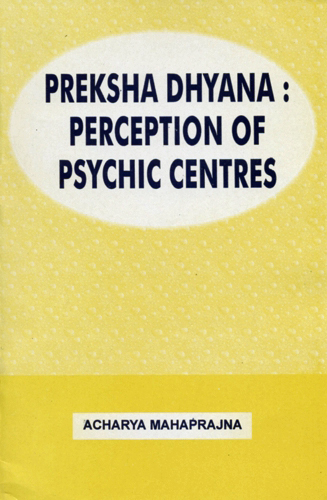Every living organism survives and functions because it is composed of a number of systems working together as a team. A system may be defined as a group of structures or organs which carry out an essential fundamental function by working together. Although, to some extent, each system works and can be considered on its own, the various systems are closely connected and are dependent on each other. Many of the activities are controlled by the nervous system and one of the characteristics of this system is the rapidity of its response to various kinds of stimuli. There is, however, a second major system which exercises control over the body's activities. The organs of this second system are called the endocrines. Thus the nervous system and the endocrine system are the two major controlling and coordinating systems of our body. They coordinate the work of other systems and through them control the functions of the body as a whole. Both are intimately associated with each other and, together integrate the organism. The functional interlocking between both qualifies them to be regarded as constituting a single integrated system called "neuroendocrine system".
The endocrine glands communicate their orders through chemical regulators called hormones. A hormone may be defined as a chemical messenger, secreted by the endocrine glands and are carried through the body by the blood-stream to its target cells in distant organs, which it is thereby able to influence. Some hormones, such as adrenalin, have an immediate action. Others exercise their influence over many years. They not only participate in all bodily functions, but exert profond influence on the menta states, emotions and behavioural patterns of an individual also. They generate the powerful forces of passions and emotions in man. These, in turn, generate feelings and demand appropriate action that satisfies the need. Love, hate, fear etc. are endocrine expressions.
For a long time it was believed that the brain was the source of energy and the seat of impulses of man. Significant progress in endocrinology (branch of science dealing with endocrine system) in the recent years has established that the passions and emotions are expressions of the endocrine system.
Endocrine system is the seat of habits formation in a person. They manifest themselves in the nervous system and become behavioural pattern. Thus manifestation and behaviour are the functions of the nervous system, but the birth-place - the production centre of the habits—is endocrine system. The same habits are then stored in the brain as memories (i.e. the brain is only the repository of memories), and ultimately become patterns of behaviour. The word neuro-endocrine system is very apt to describe the integration of both systems.
The intimate reciprocal relationship between the two systems can be illustrated as under: The visual stimulus of the beauty of a pretty girl causes eletric nerve impulses to activat the anterior pituitatry of young male, within the hypothalamus (that part of the brain which is attached to the pituitary by vascular and neural pathway) as a probable intermediary. The pituitary, in turn, produces and delivers gonadotrophic hormone to the sexual glands. The nerve and hormone signals make his heart beat faster, increase blood-pressure, tense muscles and cause sexual arousal.
Unlike continuous anatomical structures of most of the other systems of the body, the glands of the endocrine system are scattered through the body like islands. The major endocrine gland may be arranged in three groups.
-
- The anterior pituitary
- The adrenal cortex
- The thyroid gland
- The sex glands or gonads.
-
- The posterior pituitary
- The adrenal medulla
- The parathyroid
- Islets of langerhans
-
- Pineal
- Thymus
The anterior pituitary controls the other members of the frist group through the trophic hormones which it secretes. The glands of the second group are controlled by other stimuli both chemical and neural. The third group is a unique independent group.
All these glands are comparatively small, ductless and have access to very rich vascular supply. They produce organic chemical compounds called hormones which reach their targets through blood stream. They are effective in very small quantities. They regulate such important body-processes as growth and development, sexual activity, pregnancy and birth and metabolism.
A variety of trophic hormones secreted by the pituitary reach other glands via the blood-stream and stimulate each to secrete specific hormones in definite quantities. Through a feedback system of chemical inter-communication, pituitary regulates the hormone production of the other glands. (See fig I)
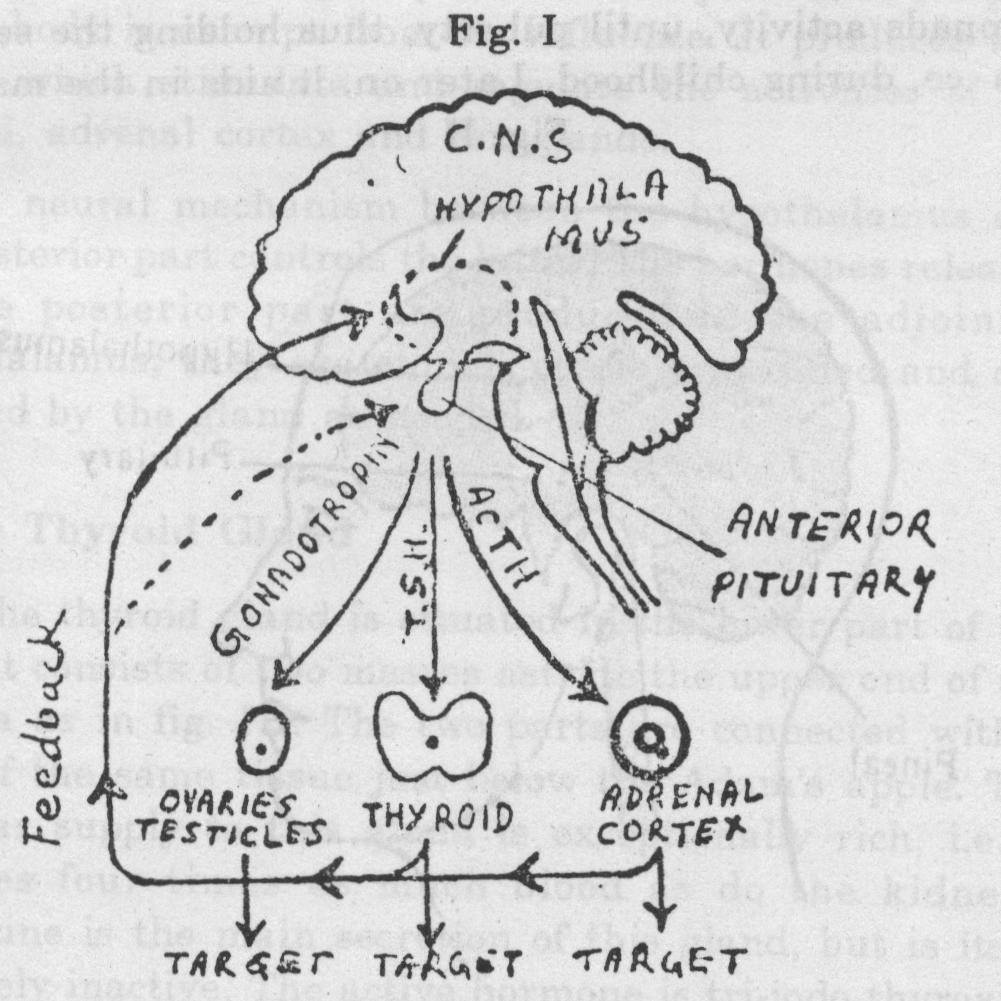
1. The Pineal Gland
This gland lies near the centre of the brain. It is very small, not much larger than a grain of wheat. It is hidden away at the base of the brain in a tiny cave behind and above the pituitary gland.
An important effect of the pineal secretion is to inhibit the gonads activity, until puberty, thus holding the sex in abeyance, during childhood. Later on, it aids in the maturing processes of sex after puberty. Some experimental evidence indicates that pineal hormones inhibit AGTH secretion and thus indirectly help to regulate the secretions of the adrenal gland, via the hypothalamus and pituitary.
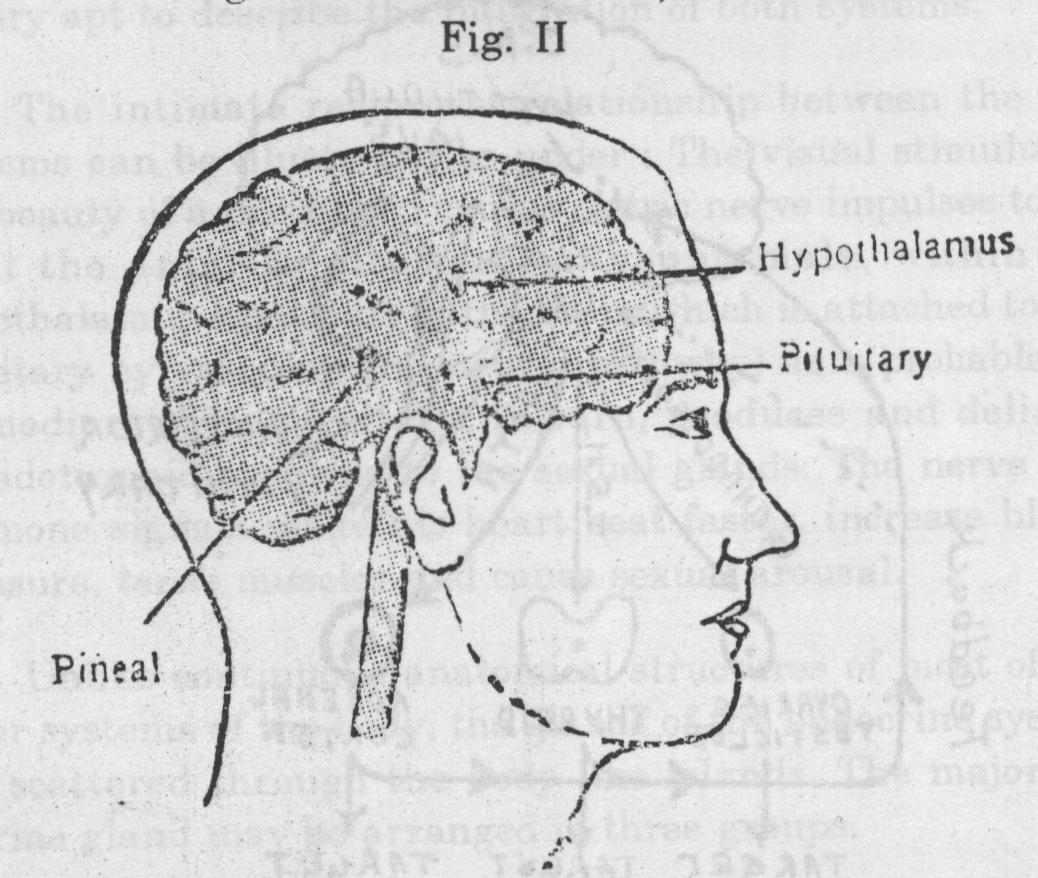
2. The Pituitary Gland
The pituitary gland is situated almost exactly in the centre of the head at the base of the brain and just behind the root of the nose (See. fig. II). It hangs suspended from the underside of the brain in a little cup or cradle. It is about the size of a pea (about 1 cm. in diameter).
This gland has an anterior and a posterior part, which have entirely different functions. Both are under the control of the hypothalamus, but by different mechanisms. The anterior part is controlled by releasing and inhibiting factors which are secreted by the hypothalamus. It produces not less than six distinctly different hormones and is concerned with the multiplicity of the vital processes. No part of the body is exempt from its influence. It produces hormones which stimulate and regulate the activities of the thyroid, adrenal cortex and sex glands.
A neural mechanism between the hypothalamus and the posterior part controls the latter. The hormones released by the posterior part are produced in the adjoining hypothalamus; they are stored, possibly modified and distributed by the gland as needed.
3. The Thyroid Gland
The thyroid gland is situated in the lower part of the neck. It consists of two masses astride the upper end of the trachea as in fig. III. The two parts are connected with a strip of the same tissue just below the Adam's apple. The vascular supply to this gland is exceptionally rich, i.e. it receives four times as much blood as do the kidneys. Thyroxine is the main secretion of this gland, but is itself relatively inactive. The active hormone is tri-iodo-thyroxine and, by its action on cells, it regulates the basal metabolic rate and influences growth and maturation. Besides the large percentage of iodine which the gland traps from the blood, it also contains iron, arsenic ana phosphorus. It is the builder of the nerve and brain tissues. Thyroid gland is essentially an energy regulating organ and its output controls the rate of metabolism or the speed of living; also it aids digestion, combats the poison in the body, gives balance to the brain, regulates protein, carbohydrate and fat metabolism and cures and prevents goitre.
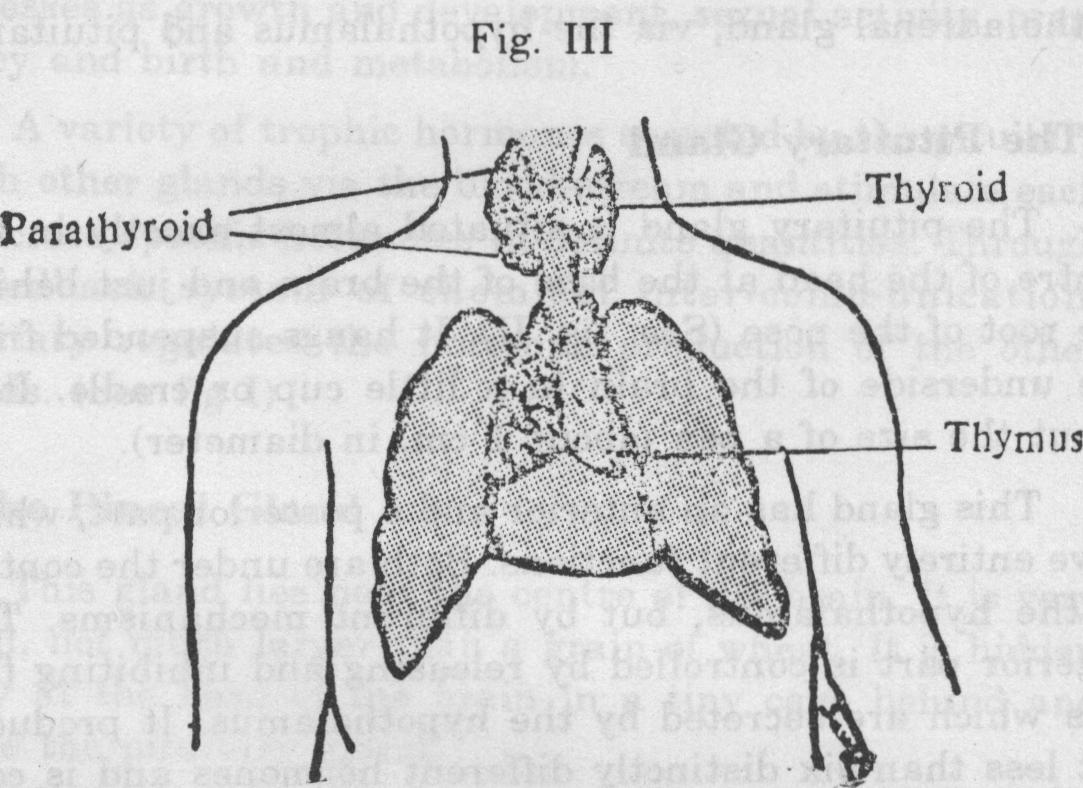
4. The Parathyroid Glands
The parathyroid glands are four minute ovid bodies, smaller than peas, embedded in the lobes of the thyroid glands. (See fig. III). The hormone secreted by these glands is called parathormone (PTH). Its action sets the long term blood calcium level which is essential for the normal function of the cells and decreases the phosphate concentration. The hormone is secreted in self-regulating feedback system independent of pituitary control.
5. The Thymus Gland
The thymus gland is situated in the chest between the two lungs, rests on the upper portion of the heart and extends up into the neck. (See fig. III). It grows rapidly during the first two or three years of the child's life and it gradually disappears after the 20th year. Some secretion-cells, however, remain throughout life. This gland is believed to control the physical growth of children upto the 14th year of age. During this time it holds other glands particularly the sex glands in check and delays puberty and furthers normal brain development.
The thymus is a lymphoid organ since it contains closely packed lymphocytes. Besides the function mentioned above, the thymus exerts an influence on the lymphonodes, spleen and other lymphatic tissues so that they too gain the ability to produce lymphocytes and foster the development of immuno-competent cells (T-cells) by means of a hormone.
6. The Adrenal Glands
The adrenals are a pair of small, flattened, yellowish, three-cornered glands capping the upper end of the kidneys. (See fig. IV). Each adrenal is a double gland composed of a cortex—an outer layer and a medulla—an inner layer; former making up the bulk of the gland. Each part has entirely separate function. The amount of blood passing through the adrenals is very great compared to their size.
More than three dozen hormones are produced by these glands. A number of these are essential to life. They stimulate the healthy growth of the brain and sex cells, develop mental concentration and physical endurance and generate a vigorous muscular and nervous constitution.
The profuse sympathetic nerve supply goes almost entirely to the medulla and the functioning of the adrenal medulla is intimately linked with the sympathetic nerve action. Fear, pain, exposure to cold, low blood pressure, and emotional upsets stimulate the release of epinephrine (also called adrenaline) and norepinephrine. These hormones are poured into the bloodstream during fear or anger and they are responsible for many of the changes which accompany these emotions. Through repeated excitement, anger, fear etc., the adrenal glands may be exhausted of their reserve supply of adrenaline. Adrenal deficiency is characterized by indecision, a tendency to worry and an inclination to weep for the slightest provocation.
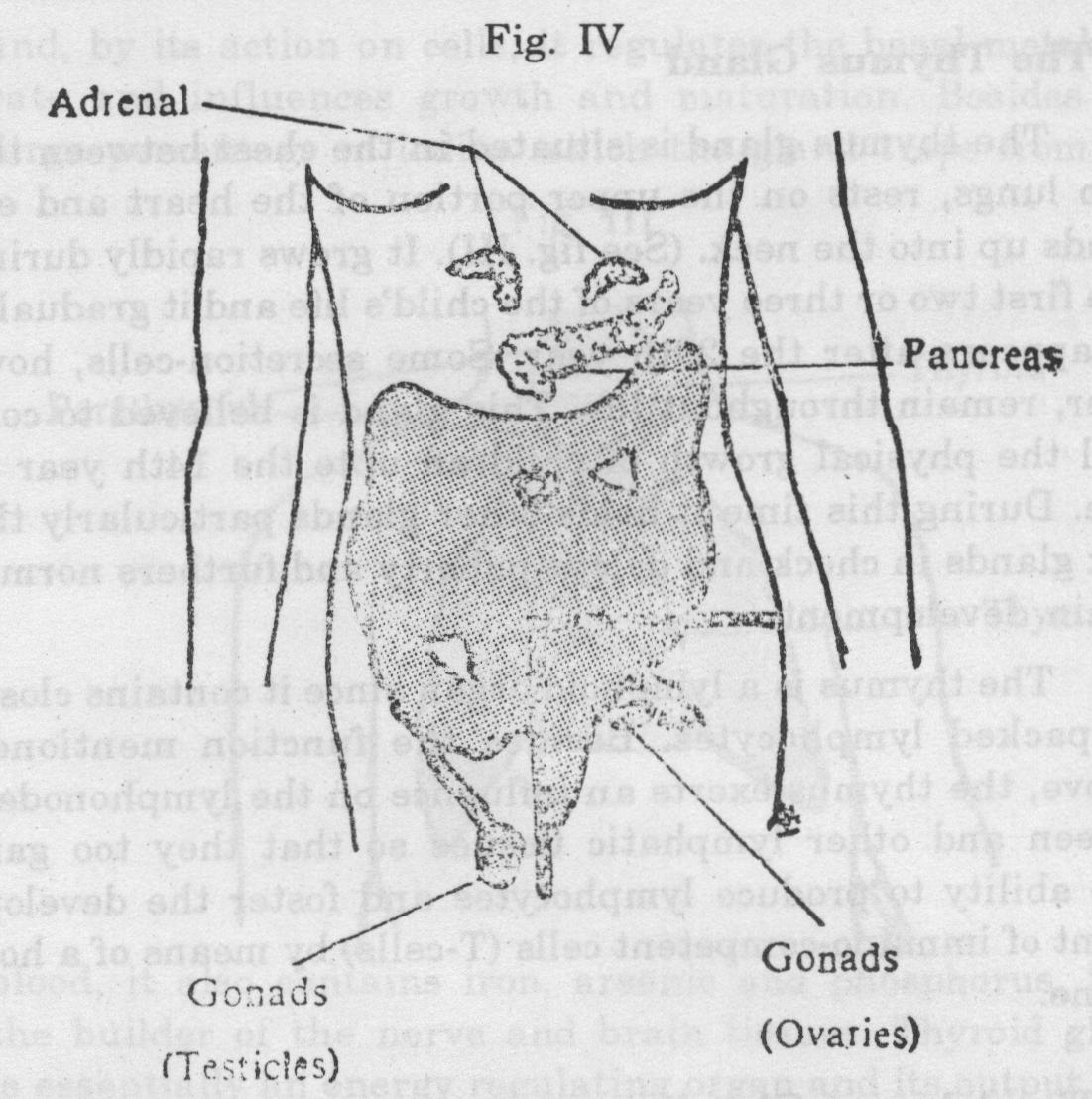
7. The Gonads (Sex Glands)
The main gonads of the female are ovaries and in the male they are the testes (See fig. IV). These organs function as potent endocrine glands secreting hormones which makes a man a male and a woman feminine. These hormones have profound influence not only on the sexual activities but also a number of body-organs and functions of an individual.
Estrogen and progesterone are the two major sex hormones which are in a large measure responsible for the characteristics that distinguish a woman from a man. The male sex-hormones are androgen and testosterone. In both sexes, pituitary hormones play a profound role in controlling the functions of the sex-glands.
Function of Endocrines
Having dealt with physical function of the endocrine system, we shall now, briefly, discuss its action on the mental states and behavioural patterns of man.
The nervous system and the endocrine system are the two major control-systems of the body. The coordinating effects of the nervous system are transmitted, nearly instantaneously by electro-chemical impulses; the endocrine glands secrete chemical regulators (hormones) which are carried through the body by the blood-stream. The action of the latter is more slowly established but longer lasting than that of the former. While nerve action is measured in milli-seconds, some hormones need several days to get started and then last for weeks, months or even years. Nerve-impulses control the function only of muscles and glands while hormones may act on all the cells of the body.
A serious study of the endocrines and their hormones commenced about the beginning of the century. It has now been known that besides the old method of chemical intercommunication between the two systems another method by nerve-action also exists. Lately, it has been realised that nervous and endocrine systems, both functioning to integrate the organism, are not as divergent as was formerly supposed. Many endocrine glands act on the nervous system through their hormones; on the other hand, endocrines are stimulated or inhibited by products of the nervous system.
Within the central nervous system, there are groups of nerve-cells, which are capable of functioning as glands. The chemical messengers released by these neuro-secretory cells are called neuro-hormones. These cells serve as link between the central nervous system and the endocrine system. With the help of these dual cells acting as go-between, the central nervous system can control the functional activity of many endocrine glands, and adjust their activity in accordance with the requirements of varying internal and external environments. Equally or more important is the reverse relationship by which the endocrine system can influence the central nervous system. This concept of the reciprocal interrelation of the two systems is now generally accepted.
Recent studies on neuro-secretions leave no doubt that the nervous system has its own endocrine specialization for the release of hormones. The functional interlocking is so remarkable that nervous and endocrine elements are coming to be regarded as constituting a single integrated system called neuro-endocrine system. As research deepens our knowledge of coordinatory systems, it becomes increasingly apparent that their products participate not only in every bodily function, but have profound influence upon the mental states and behaviour of individuals.
The neuro-endocrine system is the seat of feelings, emotions and passions of man. Impulses and urges which are the forerunners of emotions and passions, not only generate feelings but also command appropriate action that satisfy the need. Animals just act out instinctive rituals of eating, courtship and fighting because they do not possess a reasoning mind. Man, on the other hand, because he has conscious reasoning, can control his response to the insistence of the impulsive drives. Of course, man also does feel angry, hungry and sexually aroused, but he can modify his action. He could, for example, channel an erotic mood on to another creative track.
Love, hate and fear are endocrine expressions. It is the primitive urge of aggression from the endocrine, that will start war and not the brain, because no reasoning mind will ever wish to kill or injure. All the passions, emotions and impelling forces are the actions of the endocrine expressions. The reasoning mind itself has no emotions but many a time the powerful impulses from the endocrine can overwhelm and continue to tinge the supposed reasoning.
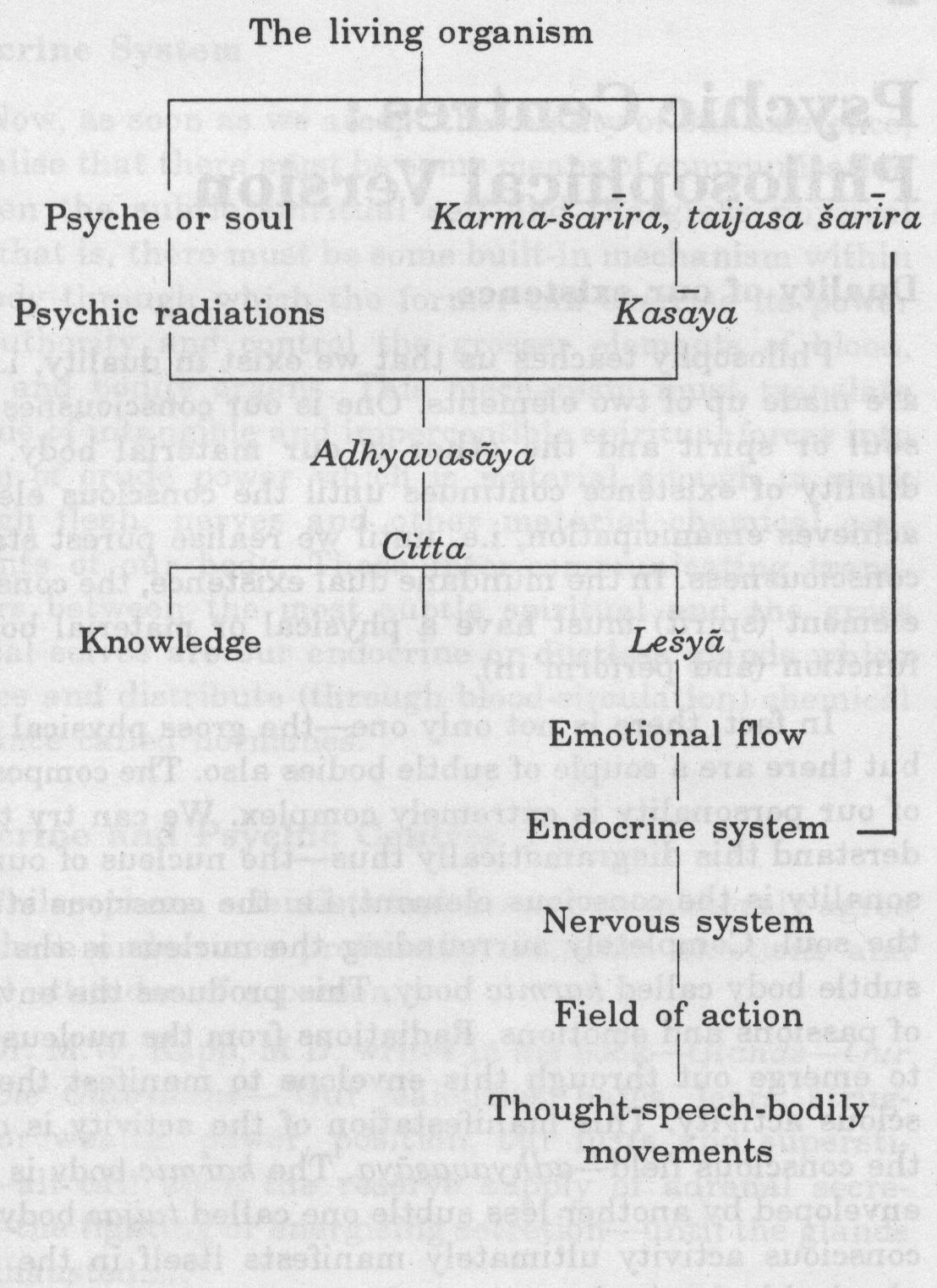
 Acharya Mahaprajna
Acharya Mahaprajna
